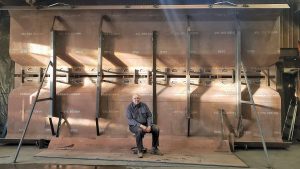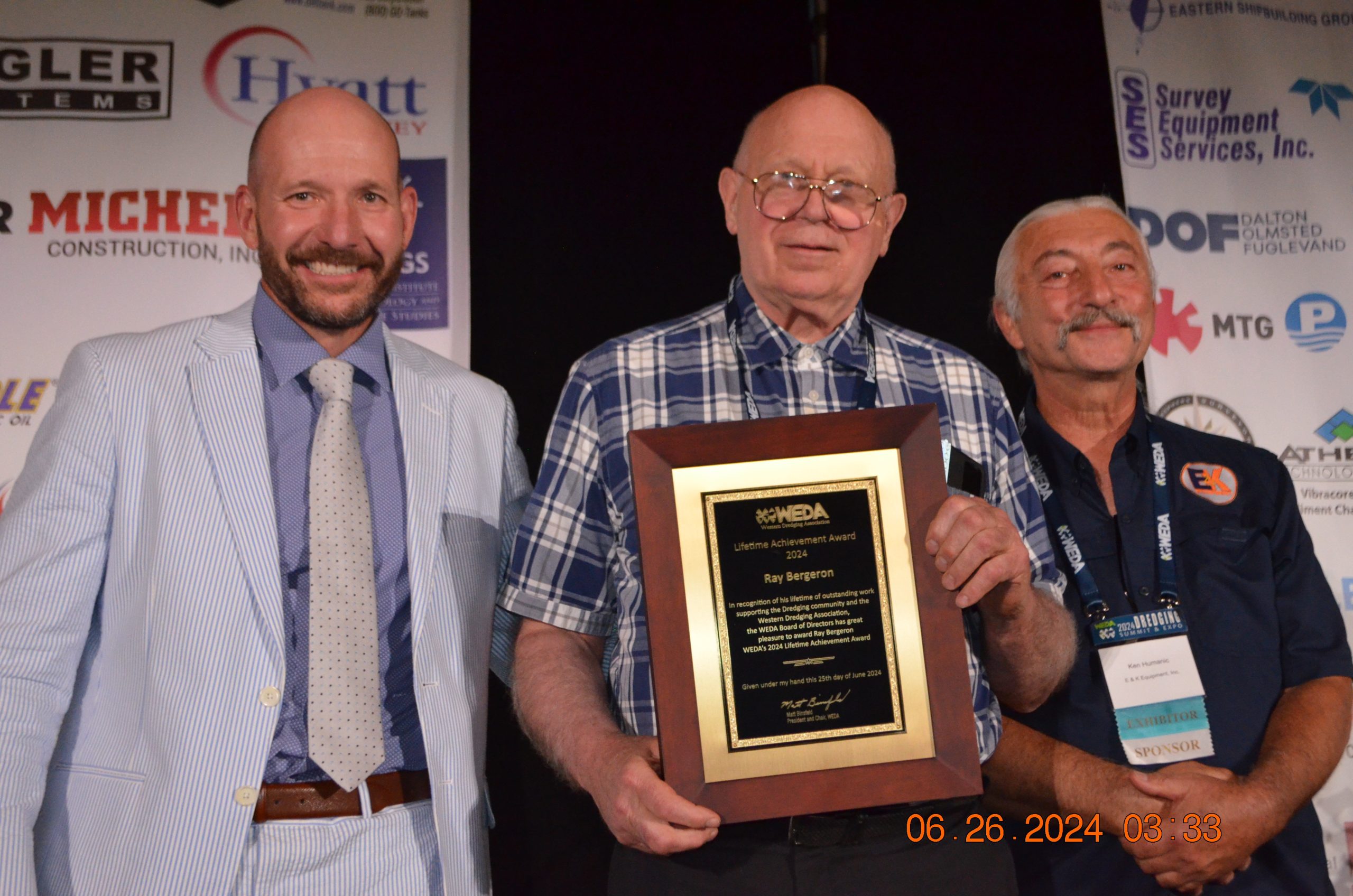For Ray Bergeron, what started as a summer job during college grew into a career that has spanned more than 60 years.
Bergeron, 80, of Trenton, Mich., founded Cable Arm, which makes custom clamshell buckets for navigation and environmental dredging. He was recently awarded a lifetime achievement award in June from the Western Dredging Association (WEDA) during the organization’s Dredging Summit and Expo in Tampa, Fla. The honor means Bergeron is one of four people to receive both dredger of the year (2010) and the lifetime achievement award from WEDA.
Bergeron credits his success to many people over the years, but his first teacher was his dad, whom he described as hard-working and “a first-class machinist.”
“Metalworking was his trade, and he was good at it,” Bergeron said.

His father owned a small welding company, and his skill with a welding torch meant he worked as an outside contractor for various businesses, including Dunbar and Sullivan Dredging Company’s Detroit yard.
That’s why the younger Bergeron approached Dunbar and Sullivan during the summer of 1962 while attending Western Michigan University in Kalamazoo.
“That’s how I got in because I knew the people there at the yard,” he said. “That gave me a great spot to learn about dredging. I went there to be a machinist-welder. I’m still doing it 60 years later.”
While at Dunbar and Sullivan, Bergeron had the opportunity to help set the pin spud stop for a Clyde 28 crane that later excavated an expansion of the Lincoln Tunnel.
Bergeron went on to receive his bachelor’s degree in mechanical engineering technology and then two master’s degrees, in mechanical engineering technology and audiovisual presentations.
He is also a U.S. Army veteran. As in most of his civilian career, he spent his time in the military working on environmental remediation. One of his memorable tasks was removing nerve gas shells from the bottom of a lake.
For about 15 years, he worked for a contractor, which bought a dredging company. That work exposed him to more opportunities, including helping to repower an 80-foot tug with a 900 hp. 149 GM engine. He also converted a 12-foot, 8-yard dipper dredge to a heavy-duty crane spud barge doing marine work.
Along the way, Bergeron always had an eye for design and found that he loved figuring out how to fabricate solutions to challenges he saw in the workplace.
In 1989, he noticed a conventional clamshell bucket bouncing off a coal pile carrying a little less than one-third of the crane-lifting capacity per grab. He was confident that he could manufacture a bucket that would increase the payload to 70 percent per grab, and his idea became the basis for the Cable Arm clamshell bucket.
By 1993, Bergeron and his company, Cable Arm Inc., began delivering patented, environmentally responsible mechanical clamshells.
The first bucket was used to offload coal and other loose-flowing materials from containers and barges, but Bergeron recognized that his new invention would be a safe tool for the removal of contaminated sediments from dredging sites. The bucket’s level, horizontal cut is designed to capture just surface level sediment, minimizing the resuspension of sediments in the water column and without capturing much water. It also means more paid material placed in the scow—and with a higher density—for transport, where water discharge is not allowed from dredging transport barges.
“The success of a dredging operation is measured by its ability to remove material quickly while meeting all applicable specifications,” Bergeron said. “Efficiency means preventing resuspension, avoiding overdredge and minimizing the number of work cycles. Cable Arm specializes in sediment clamshell buckets that cover all of these criteria to ensure that you are able to meet or exceed the specifications on your job.”
Bergeron has spent years demonstrating his buckets by appearing at dredging conferences and visiting dredging project sites. He has also continued to innovate over the years, adding the Clam Vision Positioning System for dredging and capping, a portable silt-curtained enclosure, an in-process bucket wash system and a low-turbidity operation procedure to the Cable Arm bucket.
All of the innovations have the goal of enhancing the ability of dredging contractors to safely excavate contaminated materials from numerous, high-profile cleanup sites. He has provided equipment and technical support for more than 100 environmental dredging projects in the United States since 1992, including technical advice to the Environmental Protection Agency and the U.S. Army Corps of Engineers. Additionally, he has provided advice and technical assistance in contaminated sediment removal to companies in other countries, including Canada, Peru, Mexico, Japan, the Netherlands and Germany.
The Cable Arm bucket has now become industry standard, he said.
“The old statement was if your grandfather didn’t use something, then it’s not needed in dredging, so I’ve been able to convert the whole industry in 30 years,” Bergeron said.
Bergeron builds 10 to 12 Cable Arm buckets each year from his home state of Michigan. He also continues to work to ensure that his buckets can reach distant projects, making them wider, but not as long, which has allowed him to build bigger buckets that can be shipped on trucks.
“Nobody had a bucket much over 30 yards,” he said. “Now they’re 40, 50, and there are a 72 and a 75, only because I could truck them.”Bergeron added, “The big footprint allows you to get the productivity while you’re keeping the cost down. Because of the cut level, it doesn’t overdredge sediment. You get paid for what you dredge.”
While the 75-yard bucket is currently the largest clamshell available, Bergeron said he wouldn’t be surprised if a 100-yard bucket is available before he decides to retire.
The idea of retirement is only a vague one, however.
“I’ll probably work until I die, but I have fun,” he said. “I keep making things and getting ideas and putting them together.”




